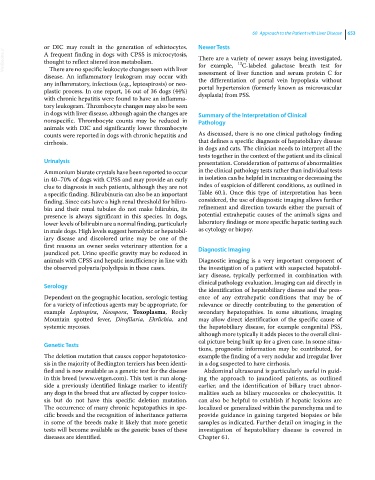Page 685 - Clinical Small Animal Internal Medicine
P. 685
60 Approach to the Patient with Liver Disease 653
or DIC may result in the generation of schistocytes. Newer Tests
VetBooks.ir A frequent finding in dogs with CPSS is microcytosis, There are a variety of newer assays being investigated,
thought to reflect altered iron metabolism.
13
C‐labeled galactose breath test for
for example,
There are no specific leukocyte changes seen with liver
disease. An inflammatory leukogram may occur with assessment of liver function and serum protein C for
the differentiation of portal vein hypoplasia without
any inflammatory, infectious (e.g., leptospirosis) or neo- portal hypertension (formerly known as microvascular
plastic process. In one report, 16 out of 36 dogs (44%) dysplasia) from PSS.
with chronic hepatitis were found to have an inflamma-
tory leukogram. Thrombocyte changes may also be seen
in dogs with liver disease, although again the changes are Summary of the Interpretation of Clinical
nonspecific. Thrombocyte counts may be reduced in Pathology
animals with DIC and significantly lower thrombocyte
counts were reported in dogs with chronic hepatitis and As discussed, there is no one clinical pathology finding
cirrhosis. that defines a specific diagnosis of hepatobiliary disease
in dogs and cats. The clinician needs to interpret all the
tests together in the context of the patient and its clinical
Urinalysis presentation. Consideration of patterns of abnormalities
Ammonium biurate crystals have been reported to occur in the clinical pathology tests rather than individual tests
in 40–70% of dogs with CPSS and may provide an early in isolation can be helpful in increasing or decreasing the
clue to diagnosis in such patients, although they are not index of suspicion of different conditions, as outlined in
a specific finding. Bilirubinuria can also be an important Table 60.1. Once this type of interpretation has been
finding. Since cats have a high renal threshold for biliru- considered, the use of diagnostic imaging allows further
bin and their renal tubules do not make bilirubin, its refinement and direction towards either the pursuit of
presence is always significant in this species. In dogs, potential extrahepatic causes of the animal’s signs and
lower levels of bilirubin are a normal finding, particularly laboratory findings or more specific hepatic testing such
in male dogs. High levels suggest hemolytic or hepatobil- as cytology or biopsy.
iary disease and discolored urine may be one of the
first reasons an owner seeks veterinary attention for a Diagnostic Imaging
jaundiced pet. Urine specific gravity may be reduced in
animals with CPSS and hepatic insufficiency in line with Diagnostic imaging is a very important component of
the observed polyuria/polydipsia in these cases. the investigation of a patient with suspected hepatobil-
iary disease, typically performed in combination with
clinical pathology evaluation. Imaging can aid directly in
Serology
the identification of hepatobiliary disease and the pres-
Dependent on the geographic location, serologic testing ence of any extrahepatic conditions that may be of
for a variety of infectious agents may be appropriate, for relevance or directly contributing to the generation of
example Leptospira, Neospora, Toxoplasma, Rocky secondary hepatopathies. In some situations, imaging
Mountain spotted fever, Dirofilaria, Ehrlichia, and may allow direct identification of the specific cause of
systemic mycoses. the hepatobiliary disease, for example congenital PSS,
although more typically it adds pieces to the overall clini-
cal picture being built up for a given case. In some situa-
Genetic Tests
tions, prognostic information may be contributed, for
The deletion mutation that causes copper hepatotoxico- example the finding of a very nodular and irregular liver
sis in the majority of Bedlington terriers has been identi- in a dog suspected to have cirrhosis.
fied and is now available as a genetic test for the disease Abdominal ultrasound is particularly useful in guid-
in this breed (www.vetgen.com). This test is run along- ing the approach to jaundiced patients, as outlined
side a previously identified linkage marker to identify earlier, and the identification of biliary tract abnor-
any dogs in the breed that are affected by copper toxico- malities such as biliary mucoceles or cholecystitis. It
sis but do not have this specific deletion mutation. can also be helpful to establish if hepatic lesions are
The occurrence of many chronic hepatopathies in spe- localized or generalized within the parenchyma and to
cific breeds and the recognition of inheritance patterns provide guidance in gaining targeted biopsies or bile
in some of the breeds make it likely that more genetic samples as indicated. Further detail on imaging in the
tests will become available as the genetic bases of these investigation of hepatobiliary disease is covered in
diseases are identified. Chapter 61.

